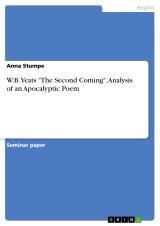Details

W.B. Yeats "The Second Coming". Analysis of an Apocalyptic Poem
1. Auflage
|
13,99 € |
|
| Verlag: | Grin Verlag |
| Format: | |
| Veröffentl.: | 08.09.2015 |
| ISBN/EAN: | 9783668042551 |
| Sprache: | englisch |
| Anzahl Seiten: | 14 |
Dieses eBook erhalten Sie ohne Kopierschutz.
Beschreibungen
Seminar paper from the year 2012 in the subject English Language and Literature Studies - Literature, Martin Luther University (Institut für Anglistik und Amerikanistik), course: William Butler Yeats, language: English, abstract: William Butler Yeats did not just believe in the apocalypse, he was known for his prophetic insights and imaginative visions of the breakdown of civilization. As the Mesoamerican Long Count Calendar ends on December, 21 in 2012, many people suggest this date marks the end of the world or of human civilization. It is of a certain interest that already in the early twentieth century Yeats was concerned with this kind of apocalyptic worldview.
“The Second Coming” therefore is one of the poems that also represents his understanding of the apocalypse, which is not comparable to those who believe in the prophecy of the Mayan calendar. “For him, the apocalypse is always connected with genuine spiritual revelation [and] with vision,” as it is the literal translation of the Greek word (Howes, Kelly 2006: 52).
With this iconic, prophetic poem, he is not only regarded a public hero but also deviates from established popular beliefs, wherefore he is also named the first iconoclastic Modernist in English writing. The stunning, violent imagery and terrifying ritualistic language makes “The Second Coming” an archetypal poem about the return of history with violence. Likewise, as it was composed in 1919 and published in 1920, it represents Yeats’ immediate reaction to the political instable situation of Ireland, England and Europe after Civil War, Russian Revolution and WWI.
In consequence to that, “The Second Coming” is one the most obscure works of Yeats, hence quite difficult to understand in the first place. For this reason, firstly, this paper concentrates on the historical and political background information, which is fundamental to the poem’s understanding.
Secondly, it is this examination’s method to analyze and interpret the poem’s form, structure and images. At that, not only “The Second Coming” in its structure but also this chapter divides into three parts, from which each displays another phase in the development of the poet’s state of mind. Consequently, each line of “The Second Coming” is examined, both to explain the poet’s development and to prove the central issues of W.B. Yeats’ poem.
Eventually, this paper provides a conclusion, wherein its argumentation is summarized. This summary consequently also states the poem’s effect on the reader.
“The Second Coming” therefore is one of the poems that also represents his understanding of the apocalypse, which is not comparable to those who believe in the prophecy of the Mayan calendar. “For him, the apocalypse is always connected with genuine spiritual revelation [and] with vision,” as it is the literal translation of the Greek word (Howes, Kelly 2006: 52).
With this iconic, prophetic poem, he is not only regarded a public hero but also deviates from established popular beliefs, wherefore he is also named the first iconoclastic Modernist in English writing. The stunning, violent imagery and terrifying ritualistic language makes “The Second Coming” an archetypal poem about the return of history with violence. Likewise, as it was composed in 1919 and published in 1920, it represents Yeats’ immediate reaction to the political instable situation of Ireland, England and Europe after Civil War, Russian Revolution and WWI.
In consequence to that, “The Second Coming” is one the most obscure works of Yeats, hence quite difficult to understand in the first place. For this reason, firstly, this paper concentrates on the historical and political background information, which is fundamental to the poem’s understanding.
Secondly, it is this examination’s method to analyze and interpret the poem’s form, structure and images. At that, not only “The Second Coming” in its structure but also this chapter divides into three parts, from which each displays another phase in the development of the poet’s state of mind. Consequently, each line of “The Second Coming” is examined, both to explain the poet’s development and to prove the central issues of W.B. Yeats’ poem.
Eventually, this paper provides a conclusion, wherein its argumentation is summarized. This summary consequently also states the poem’s effect on the reader.
Diese Produkte könnten Sie auch interessieren:

Politeness in Shakespeare: Applying Brown and Levinson´s politeness theory to Shakespeare's comedies

von: Abdelaziz Bouchara

43,00 €















